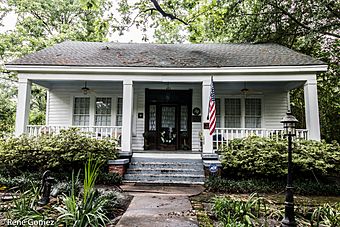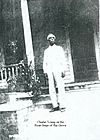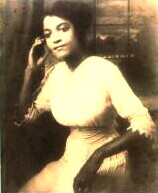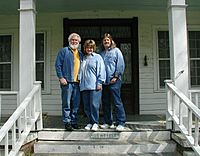The Grove (Jefferson, Texas) facts for kids
|
Stilley–Young House
|
|

The Grove (Stilley-Young House)
|
|
| Location | 405 Moseley St., Jefferson, Texas |
|---|---|
| Area | 0.5 acres (0.20 ha) |
| Built | 1861 |
| Architectural style | Greek Revival |
| NRHP reference No. | 05001105 |
Quick facts for kids Significant dates |
|
| Added to NRHP | September 28, 2005 |
The Grove (also known as the Stilley–Young House) is a historic home in Jefferson, Texas. It was built in 1861 and is listed on the National Register of Historic Places. It is also a Recorded Texas Historic Landmark. Many people call The Grove the most haunted place in Texas.
The Grove has been shown on TV shows like If Walls Could Talk on HGTV. This Old House magazine named it one of the top twelve most haunted houses in America. Texas Monthly magazine also called it one of the "eight scariest places in Texas." The house was even featured in William Shatner's show Weird or What? in 2012.
Contents
Discover the Architecture of The Grove
The Grove looks like a Greek Revival home from the outside. But if you look closely, you can also see parts of Creole Architecture. The house is a one-story building made of wood. Its main beams are cypress, covered with wooden siding.
The house was built in 1861. It mixes two styles: Greek Revival and French Creole. Many homes in Jefferson at that time were Greek Revival. But the first owner, Frank Stilley, was from Louisiana. This is likely why he added French Creole touches to the design. Because Jefferson traded a lot with Louisiana by riverboat in the 1800s, The Grove is a special example of the area's past.
It's great that no owners have tried to "modernize" The Grove. The house still looks much like it did after a small update in the 1930s. By keeping its history safe, The Grove reminds us of the region's past for future generations.
A Look at The Grove's History
The land where The Grove stands was first given to Daniel and Lucy Alley. They helped start the city of Jefferson. On June 9, 1847, Amos Morrill bought the property. He was a lawyer and the first federal judge in Texas. He built a log cabin there.
Morrill sold the land to Caleb and Sarah Ragin on March 20, 1855. Then, on November 13, 1861, Frank Stilley and his wife, Minerva Fox, bought the land. They built the house that became known as The Grove.
The Stilley Family's Time at The Grove
W. Frank Stilley worked with cotton in Jefferson. He married Minerva Fox in 1860. Her father paid for their new home as a wedding gift. The house was finished in 1861, and the young couple moved in.
Between 1870 and 1880, the Stilleys faced tough times. A flood ruined Frank Stilley's cotton business. Then, in 1873, the U.S. Army Corps of Engineers cleared the Great Raft from the Red River. This caused the water level in Big Cypress Bayou to drop. It became too hard to ship goods, which hurt Frank's business even more.
In 1879, Minerva Fox Stilley passed away. After her burial, Frank Stilley moved away. He put The Grove up for sale.
The Stockade Case
During the Reconstruction period, a serious event happened. It was called the Stockade Case. This event helped give The Grove its reputation for being haunted.
It started when a man named George W. Smith came to Jefferson. He made people angry with his words. To keep him safe, the Union Army put Smith and his friends in the public jail. That night, a group of angry locals gathered. They entered the jail and took Smith out. He was killed. The four men with him were also killed near Moseley Street. Records show The Grove was one of the places where this event happened.
The Rock Family Owns The Grove
Minerva Stilley's estate sold The Grove to Daniel C. Rock and his wife Amanda on February 1, 1880. Daniel Rock was a "bridge builder." With the "Great Raft" cleared, river levels changed. Building bridges was likely a good job at that time.
The Burks Family's Short Stay
The Rock family sold The Grove to Mr. T.C. Burks in 1882. But the Burks family returned the property within six months. No one knows why they changed their minds, only that they didn't want to live there. The Burks family moved to Athens, Texas.
Daniel and Amanda Rock took back The Grove. They lived there for three more years. In 1885, the Rocks moved to Paris, Texas. It's thought that Daniel's bridge-building work in Jefferson might have ended.
The Charlie Young Family at The Grove
On March 6, 1885, Charles and Daphne Young bought The Grove. They were an African-American couple who had been born into slavery. Charlie became a barber in Jefferson after he was freed.
In 1908, the Young family faced sadness when their son, James, died at the house. His burial place is unknown. Charlie and Daphne lived at The Grove until they passed away in 1938 and 1955. When Charlie Young died, he left The Grove to his oldest daughter, Louise.
Louise Young's Long Ownership
Louise took over The Grove. She lived there and cared for her mother, Daphne. Daphne Young loved the gardens at The Grove. Her funeral was held on the front porch so she could be near her beloved garden one last time.
In the 1930s, Louise Young made a change to the house. She closed in the back porch to create an indoor bathroom. This means the bathroom is where her brother James died.
Louise lived at The Grove her whole life, except for four years. She went to Bishop College to become a teacher. People who knew Louise said she was often scared. She put strong locks on every door and window. She also had bright lights installed to keep the yard lit. She often called the police about people she thought were trying to get into the house. Louise died in 1983 at age 96, having spent almost her entire life at The Grove.
The Grove Family Buys The Grove
After Louise Young died, Colonel Daniel M. and Lucile Grove bought the property on November 9, 1983. Colonel Grove was a retired military chaplain. The house needed repairs, like a new roof and fixing the porch. The garden was also very overgrown.
The Groves started to get the house ready for their retirement. But before they could finish, Colonel Grove became very ill. Mrs. Grove had to sell the house.
Patrick Hopkins' Time at The Grove
Lucile Grove sold the property to chef Patrick Hopkins on January 16, 1990. Patrick Hopkins had a dream of opening a restaurant in an old house in Jefferson. He found The Grove, which was covered in vines, with a "For Sale" sign.
Patrick Hopkins and his sister, Mary Hopkins Callas, began fixing up the house. They opened it as a restaurant. The restaurant served delicious food and hosted special events. It received great reviews from newspapers and authors. The Grove remained a restaurant for several years before Mr. Hopkins closed it.
Recent History of The Grove
The current owners, Mitchel and Tami Whitington, bought the house in 2002. Mitchel is an author and works in publishing. Tami is a teacher at Jefferson High School. They found the house during a visit to Jefferson.
In 2006, the Texas Historical Commission recognized The Grove as a Recorded Texas Historic Landmark. This means it's an important historical place in Texas.
The Ghosts of The Grove
The Grove has many stories of strange things happening. People have heard voices, footsteps, and seen objects move. These stories make many believe The Grove is the most haunted building in Jefferson, and maybe all of Texas.
Patrick Hopkins, the former owner, said many mysterious things happened when he lived there. Mirrors fell off walls, loud cries came from upstairs, and he often felt watched. Some legends say that several murders happened on the property. There might even be unmarked graves under or near the house.
Hopkins's niece once saw a dark figure lying in the street. When she went to help, the figure disappeared. This could be one of the men from the Stockade Case. Or it could be another man rumored to have been killed on the back porch.
A ghostly woman has also been seen many times at The Grove. Hopkins saw her in the house before he opened the restaurant. A neighbor also saw a "glowing white figure" on the porch. People say this woman is Minerva Fox Stilley, the first owner. She is often seen walking next to the house. Then, she seems to walk through a wall. This makes more sense when you know that the wall was once the back porch. She might be stepping onto the porch and walking into what was once the children's bedroom.







